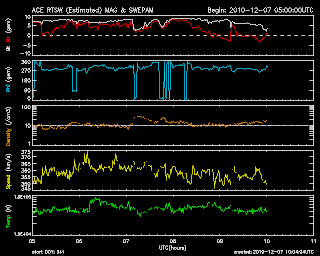
Well we had a real countdown today on the Renu rocket. We got to T-2 minutes, and had to hold because the conditions were not quite right. Our rocket is looking at neutral upwelling caused by geomagnetic heating. Basically we are trying to figure out the exact mechanism that causes the heating. Anyway we need geomagnetic heating, and to get that we look at the aurora and the EISCAT radar. We also track the solar wind conditions by looking at data from the Ace satellite. Ace is "upstream" at the L1 Lagrange point, and gives us about 1 hour advanced warning of what is coming. We had a good solar wind today, but the sign of the suns magnetic field was positive, and we need it to be negative. You can see a plot of what we are looking at here. The stength of the Suns magnetic field is measured in nano Tesla, and today the total field strength was ok at about 5 nT (the white line in the top panel). The vertical component of the magnetic field is called Bz, and we need it negative. It was positive all morning, with a brief swing negative just as we had to leave. Basically this results in the aurora being too far to the north for the rocket to get there before we splash down. Hopefully tomorrow will be better.





